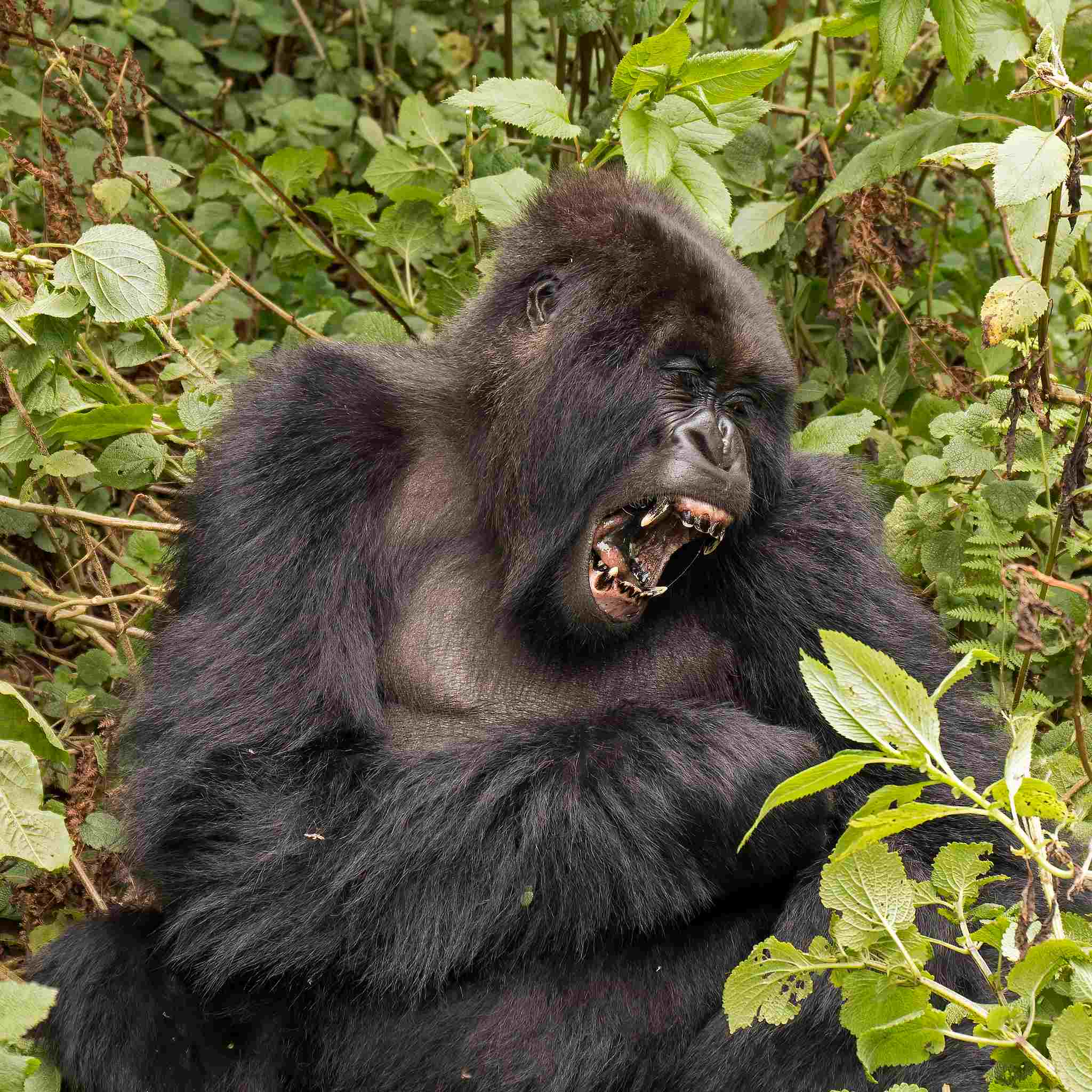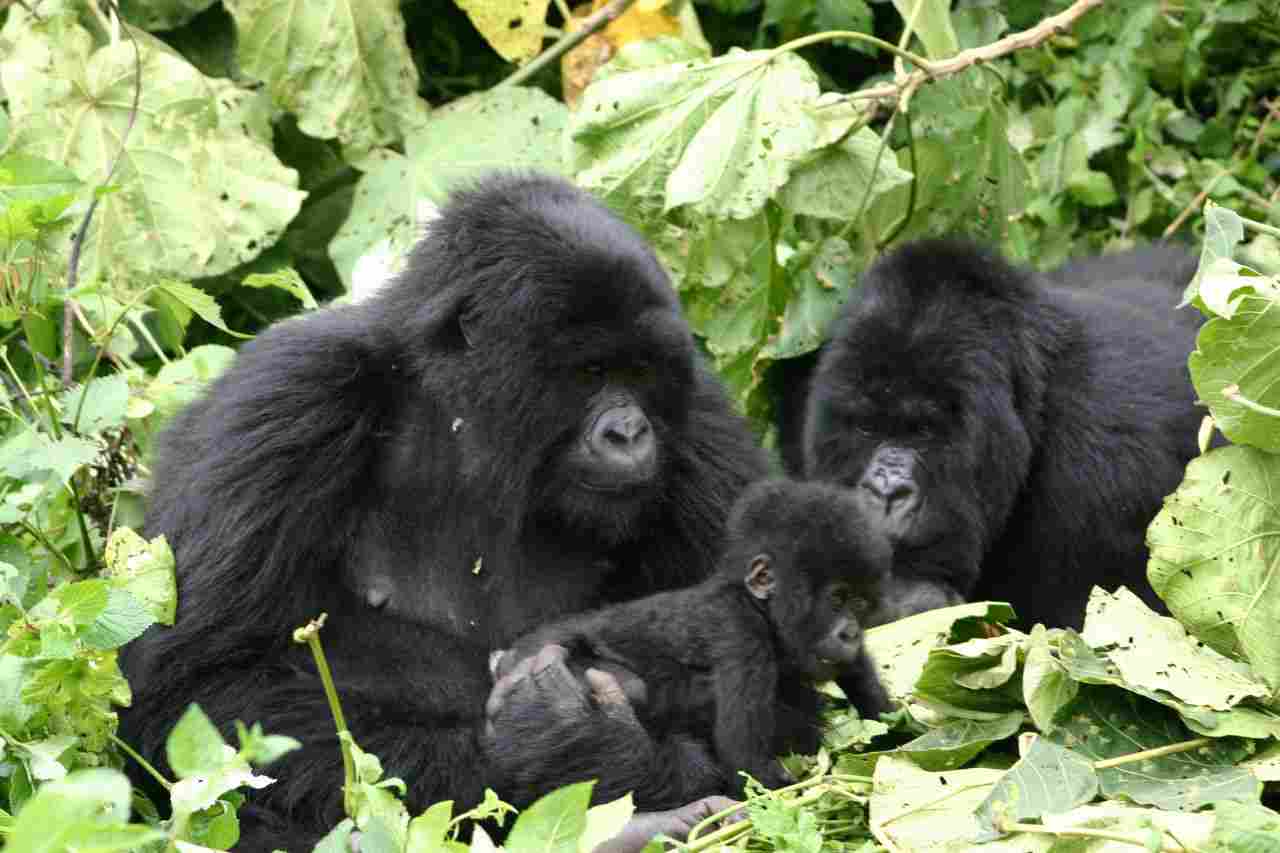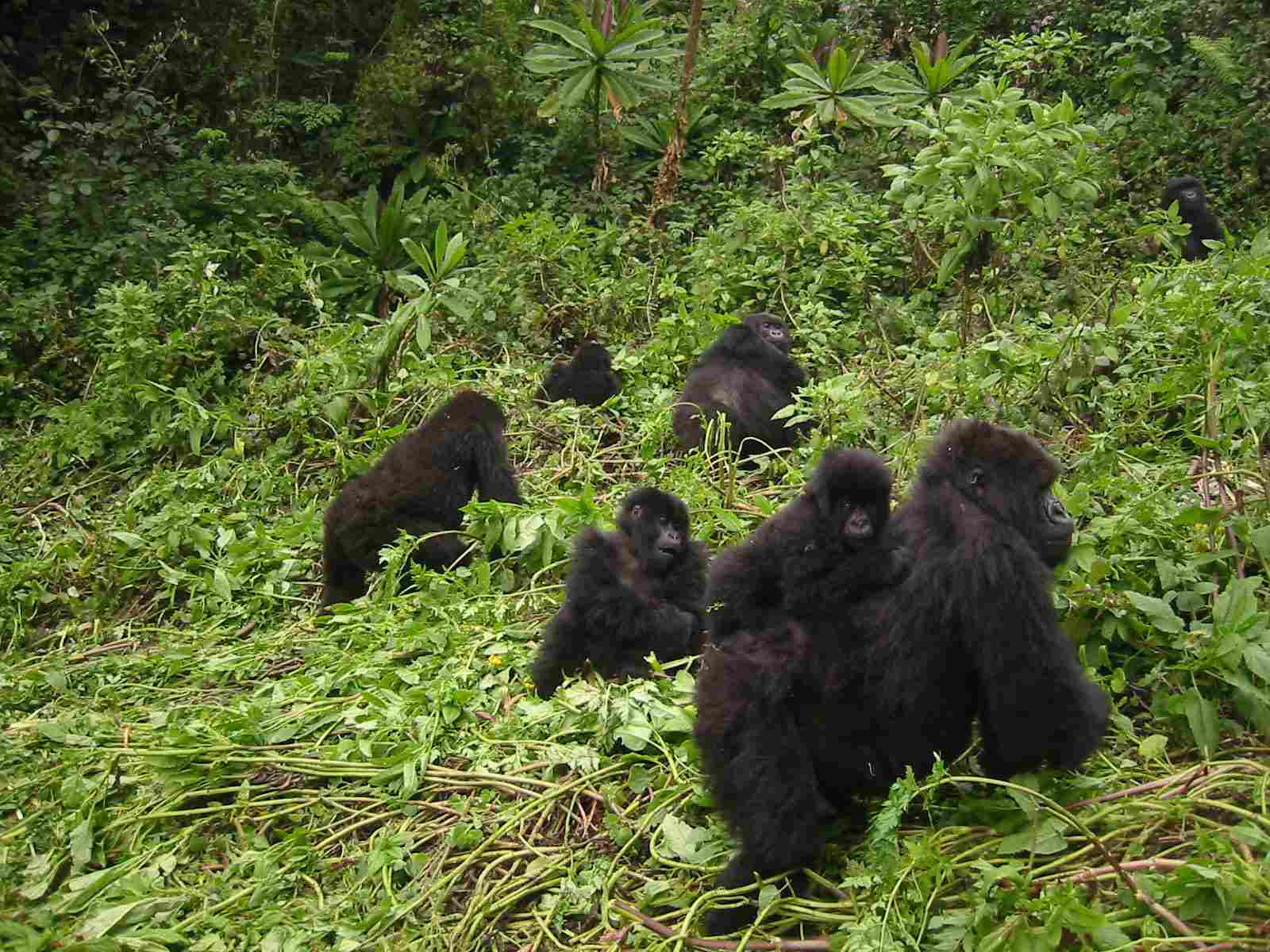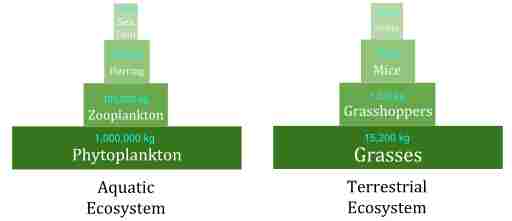Gorilla Vs Human Size, Strength. Weight. Overall Comparison
Gorillas and humans, both members of the primate family, present a unique exploration of biological and physical traits. Gorillas, symbolizing strength, inhabit dense forests, while humans, with their distinct characteristics, have adapted to diverse environments.
This analysis delves into taxonomy, appearance, size, weight, strength, and aggressiveness to assess the potential outcome of a one-on-one confrontation between a gorilla and a human.
Gorilla vs Human: Who Will Win in a Fight/Physical Confrontation?
In a one-on-one confrontation, a lone gorilla is likely to overpower a human due to its superior weight, immense strength, and heightened aggressiveness.

I). Weight Advantage:
– Gorillas, being significantly heavier than humans, establish a substantial advantage in one-on-one confrontations, using their weight to dominate.
II). Strength Advantage:
– The sheer strength of gorillas far surpasses that of humans, providing them with the physical power needed to overcome opponents in confrontational scenarios.
III). Aggressiveness Advantage:
– Marked by a more aggressive nature, gorillas outmatch humans in confrontational scenarios, showcasing a formidable demeanor that contributes to their success.
While humans possess intelligence and adaptability, these traits may not be sufficient in a direct physical confrontation with a gorilla.
*Details of Comparison
| Aspect | Gorilla | Human |
| Taxonomy | Order: Primates, Family: Hominidae, Genus: Gorilla, Species: Gorilla beringei, Gorilla gorilla |
Order: Primates, Family: Hominidae, Genus-Species: Homosapiens
|
| Appearance | Robust build, dark hair, prominent brow ridge |
Diverse body types, varied hair and skin colors, less prominent brow ridge
|
| Size | Males: 5.6-6 feet, Females: Smaller |
Varied heights, males: 5.5-6.2 feet, females generally shorter
|
| Weight | Males: 300-400 pounds, Females: Smaller |
Varied weights, males: 130-200 pounds, females generally lighter
|
| Bite Force | Powerful, large jaws |
Weaker bite force compared to gorillas
|
| Physical Offensive Advantages | Strong arm muscles, powerful grip |
Tool use, strategic thinking
|
| Physical Defensive Advantages | Powerful physique, dominance displays |
High-level cognitive skills, social cooperation
|
| Speed | Limited ground speed |
Efficient bipedal locomotion, varied running speeds
|
| Agility | Strong climbers, agile in trees |
Agile and adaptable on the ground, capable climbers
|
| Overall Physical Capacity | Specialized for strength and climbing |
Generalized physical abilities, higher endurance
|
| Habitat Preference(s) | Dense forests, high-altitude areas |
Highly adaptable, occupies a wide range of environments
|
| Tracks | Distinct hand and foot impressions, prominent toe prints |
Clear arch and heel impressions, less emphasis on hands
|
| Lifespan | 35-40 years in the wild |
Varied, but average around 72 years globally
|
| Mode of Feeding | Herbivorous, consumes leaves, stems, fruits |
Omnivorous, wide range of plant and animal-based foods
|
| Social Behavior | Live in cohesive groups, dominance hierarchy |
Complex social structures, varied social organizations
|
| Mode of Reproduction | Polygynous mating, single offspring per gestation |
Varied mating systems, typically monogamous, single offspring per gestation
|
| Parental Behavior | Strong maternal care, extended dependence |
Varied parenting styles, extended period of offspring dependence
|
| Proximity to Human-Inhabited Areas | Primarily in remote, forested regions |
Global distribution, including urban, rural, and remote areas
|
| Behavior Toward Humans | Generally shy and avoidant |
Varied, ranging from friendly to aggressive
|
| Danger Posed to Humans | Typically not dangerous unless provoked |
Varied, ranging from non-threatening to harmful
|
| Associated Precautions | Recommended viewing from a distance, minimal interference |
Varied precautions based on context and culture, emphasis on respecting laws and societal norms
|
| Conservation Status | Varied, often endangered or critically endangered |
Not formally classified
|
Key Points:
1. Taxonomy:
Gorilla:
Order: Primates
Family: Hominidae
Genus: Gorilla
Species: Gorilla beringei (Mountain Gorilla), Gorilla gorilla (Western Gorilla)
Human:
Order: Primates
Family: Hominidae
Genus-Species: Homosapiens
2. Appearance:
Gorilla:
Robust, muscular build
Prominent brow ridge
Coarse, dark hair
Black skin
Human:
Varied body types
Lighter, less dense hair
Skin color diversity
Less prominent brow ridge
Comparison: Gorillas exhibit a more uniform appearance, emphasizing physical strength, while humans display greater diversity in body types and features.
Ecological Implications: Gorilla appearance aligns with their adaptation for forest life, aiding in camouflage and physical dominance. Human diversity reflects adaptability to various environments.
3. Size:

Gorilla:
Adult males: 5.6 to 6 feet (1.7 to 1.8 meters)
Adult females: Smaller than males
Human:
Varied heights
Adult males: 5.5 to 6.2 feet (1.7 to 1.9 meters)
Adult females: Generally shorter
Comparison: Gorillas are shorter on average, with males exhibiting sexual dimorphism. Humans display more height variability.
Ecological Implications: Gorilla size aids in maneuvering through dense forests, providing advantages in their arboreal habitats. Human height diversity supports adaptability to different ecological niches.
4. Weight:
Gorilla:
Adult males: 300 to 400 pounds (136 to 181 kilograms)
Adult females: Smaller than males
Human:
Varied weights
Adult males: 130 to 200 pounds (59 to 91 kilograms)
Adult females: Generally lighter
Comparison: Gorillas are substantially heavier, reflecting their muscular build. Humans exhibit a wider weight range.
Ecological Implications: Gorilla weight contributes to ground stability in their forest habitat. Human weight variability reflects adaptability to diverse environments.
5. Bite Force:
Gorilla:
Powerful bite force with large, strong jaws
Human:
Weaker bite force compared to gorillas
Comparison: Gorillas possess a stronger bite force, suited for their herbivorous diet and ecological role. Humans have a comparatively weaker bite force.
Ecological Implications: Gorilla bite strength aids in processing tough plant materials. Human bite adaptation aligns with a broader dietary spectrum and tool use.
6. Physical Offensive Advantages:
Gorilla:
Strong arm muscles
Powerful grip
Human:
Tool use
Strategic thinking
Comparison: Gorillas rely on physical strength, while humans leverage tools and strategic planning for offense.
Ecological Implications: Gorilla reliance on physical strength suits their natural environment. Human tool use reflects adaptability and cognitive advantages.
7. Physical Defensive Advantages:
Gorilla:
Powerful physique
Dominance displays
Human:
High-level cognitive skills
Social cooperation
Comparison: Gorillas primarily use physical dominance for defense, while humans employ cognitive and social strategies.
Ecological Implications: Gorilla dominance serves as a deterrent in their natural habitat. Human reliance on cognitive and social defenses highlights adaptability and complex societal structures.
8. Speed:
Gorilla:
Limited ground speed
Human:
Efficient bipedal locomotion
Varied running speeds
Comparison: Gorillas are slower on the ground due to their quadrupedal movement. Humans excel in bipedal locomotion, allowing for faster and more efficient travel.
Ecological Implications: Gorilla speed aligns with their habitat where agility and climbing are more crucial. Human bipedalism contributes to versatility in diverse environments.
9. Agility:

Gorilla:
Strong climbers
Agile in trees
Human:
Agile and adaptable on the ground
Capable climbers
Comparison: Gorillas demonstrate agility in trees, while humans exhibit versatility in both arboreal and terrestrial environments.
Ecological Implications: Gorilla agility aids in navigating the forest canopy. Human adaptability supports survival in various landscapes.
10. Overall Physical Capacity:
Gorilla:
Specialized for strength and climbing
Limited endurance
Human:
Generalized physical abilities
Higher endurance
Comparison: Gorillas excel in strength and climbing, while humans have a more balanced and enduring physical capacity.
Ecological Implications: Gorilla specialization aligns with their forest habitat. Human versatility contributes to survival in diverse ecosystems.
11. Habitat Preference(s):

Gorilla:
Dense forests
Prefer high-altitude areas
Human:
Highly adaptable
Occupies a wide range of environments
Comparison: Gorillas have a specific preference for dense forested areas, while humans thrive in diverse habitats.
Ecological Implications: Gorilla habitat preference reflects adaptation to specific ecological niches. Human adaptability allows occupation of various environments.
12. Tracks:
Gorilla:
Distinct hand and foot impressions
Toe prints more prominent
Human:
Clear arch and heel impressions
Fingertips less prominent
Comparison: Gorilla tracks emphasize the use of both hands and feet, while human tracks highlight bipedalism with less emphasis on hands.
Ecological Implications: Gorilla tracks indicate their arboreal lifestyle. Human tracks showcase efficient bipedal locomotion, aiding in long-distance travel.
13. Lifespan:
Gorilla:
35 to 40 years in the wild
Human:
Varied, but average around 72 years globally
Comparison: Gorillas have a shorter lifespan compared to humans.
Ecological Implications: Gorilla reproductive strategies and lifespan contribute to population dynamics in their habitats. Human longevity impacts social structures and ecological footprint.
14. Mode of Feeding:
Gorilla:
Herbivorous diet
Mainly consumes leaves, stems, and fruits
Human:
Omnivorous diet
Consumes a wide range of plant and animal-based foods
Comparison: Gorillas are specialized herbivores, while humans are adaptable omnivores.
Ecological Implications: Gorilla feeding habits shape their role in maintaining forest ecosystems. Human dietary flexibility contributes to versatility in different environments.
15. Social Behavior:

Gorilla:
Live in cohesive groups (troops)
Dominance hierarchy within groups
Human:
Complex social structures
Varied social organizations
Comparison: Gorillas exhibit group living with a defined hierarchy, while human social structures are diverse and complex.
Ecological Implications: Gorilla social structures aid in group coordination within their forest habitat. Human social complexity supports adaptability and cooperation in diverse environments.
16. Mode of Reproduction:
Gorilla:
Polygynous mating system
Single offspring per gestation
Human:
Varied mating systems, predominantly monogamous
Typically single offspring per gestation
Comparison: Gorillas often engage in polygynous mating, while human mating systems vary, with a tendency towards monogamy.
Ecological Implications: Gorilla mating strategies contribute to genetic diversity within their populations. Human mating systems influence family structures and social dynamics.
17. Parental Behavior:
Gorilla:
Strong maternal care
Extended period of offspring dependence
Human:
Varied parenting styles
Extended period of offspring dependence
Comparison: Gorillas and humans both exhibit extended periods of parental care, with differences in parenting styles.
Ecological Implications: Gorilla maternal care supports offspring survival in their natural environment. Human parenting styles contribute to cultural diversity and societal structures.
18. Proximity to Human-Inhabited Areas:
Gorilla:
Primarily in remote, forested regions
Human:
Global distribution, including urban, rural, and remote areas
Comparison: Gorillas are mainly found in remote, natural habitats, whereas humans inhabit a wide range of environments, including urban areas.
Ecological Implications: Gorilla remoteness minimizes direct interaction with human activities, allowing them to maintain their ecological role. Human presence in diverse areas affects ecosystems differently.
19. Behavior Toward Humans:
Gorilla:
Generally shy and avoidant of humans
Human:
Diverse behaviors, from friendly to aggressive
Comparison: Gorillas often exhibit avoidance of humans, contrasting with the varied behaviors humans display towards each other.
Ecological Implications: Gorilla avoidance contributes to their conservation by reducing human-wildlife conflicts. Human behaviors towards each other shape societal dynamics and cultural interactions.
20. Danger Posed to Humans:
Gorilla:
Typically not dangerous unless provoked
Human:
Varied, ranging from non-threatening to harmful
Comparison: Gorillas are generally non-aggressive unless provoked, contrasting with the diverse range of human behaviors.
Ecological Implications: Gorilla non-aggression contributes to their conservation by reducing the likelihood of conflict. Human behaviors impact various ecosystems and species.
21. Associated Precautions:
Gorilla:
Recommended viewing from a distance
Minimal interference in natural behavior
Human:
Varied precautions based on context and culture
Emphasis on respecting laws and societal norms
Comparison: Gorillas require respectful viewing at a distance, while human precautions involve adherence to diverse societal norms and legal regulations.
Ecological Implications: Gorilla viewing precautions contribute to conservation efforts. Human adherence to rules and norms shapes interactions within and across societies.
22. Conservation Status:

Gorilla:
Varied conservation statuses based on species
Endangered or critically endangered
Human:
Not formally classified
Comparison: Gorillas face significant conservation challenges with various species being endangered, while humans, as a species, are not formally classified in conservation terms.
Ecological Implications: Gorilla conservation efforts are critical to preserving biodiversity in their habitats. Human impacts on ecosystems necessitate sustainable practices for long-term environmental health.
Summary
1. Taxonomy:
Gorillas belong to the order Primates, family Hominidae, genus Gorilla, and species Gorilla beringei or Gorilla gorilla.
Humans belong to the order Primates, family Hominidae, and genus-species Homosapiens.
2. Appearance:
Gorillas have a robust build, dark hair, and a prominent brow ridge.
Humans exhibit diverse body types, varied hair and skin colors, and a less prominent brow ridge.
3. Size:
Gorilla males are 5.6-6 feet, females smaller. Humans display varied heights, with males at 5.5-6.2 feet, and females generally shorter.
4. Weight:
Gorilla males weigh 300-400 pounds, females less. Human weights vary, with males at 130-200 pounds and females generally lighter.
5. Bite Force:
Gorillas have a powerful bite force with large jaws.
Humans exhibit a weaker bite force compared to gorillas.
6. Physical Offensive Advantages:
Gorillas rely on strong arm muscles and a powerful grip.
Humans use tool use and strategic thinking for offense.
7. Physical Defensive Advantages:
Gorillas have a powerful physique and display dominance.
Humans employ high-level cognitive skills and social cooperation for defense.
8. Speed:
Gorillas have limited ground speed.
Humans excel in efficient bipedal locomotion with varied running speeds.
9. Agility:
Gorillas are strong climbers and agile in trees.
Humans are agile and adaptable on the ground, capable climbers.
10. Overall Physical Capacity:
Gorillas are specialized for strength and climbing with limited endurance.
Humans have a generalized physical capacity with higher endurance.
11. Habitat Preference(s):
Gorillas prefer dense forests and high-altitude areas.
Humans are highly adaptable and occupy a wide range of environments.
12. Tracks:
Gorilla tracks have distinct hand and foot impressions with prominent toe prints.
Human tracks show clear arch and heel impressions with less emphasis on hands.
13. Lifespan:
Gorillas have a lifespan of 35-40 years in the wild.
Humans have a varied lifespan but average around 72 years globally.
14. Mode of Feeding:
Gorillas are herbivores, consuming leaves, stems, and fruits.
Humans are omnivores, with a wide range of plant and animal-based foods.
15. Social Behavior:
Gorillas live in cohesive groups with a dominance hierarchy.
Humans exhibit complex social structures with varied social organizations.
16. Mode of Reproduction:
Gorillas have a polygynous mating system and typically one offspring per gestation.
Humans have varied mating systems, predominantly monogamous, with typically one offspring per gestation.
17. Parental Behavior:
Gorillas show strong maternal care and an extended period of offspring dependence.
Humans display varied parenting styles with an extended period of offspring dependence.
18. Proximity to Human-Inhabited Areas:
Gorillas are primarily found in remote, forested regions.
Humans have a global distribution, including urban, rural, and remote areas.
19. Behavior Toward Humans:
Gorillas are generally shy and avoidant of humans.
Humans exhibit varied behaviors, ranging from friendly to aggressive.
20. Danger Posed to Humans:
Gorillas are typically not dangerous unless provoked.
Humans pose varied levels of danger, ranging from non-threatening to harmful.
21. Associated Precautions:
Gorillas require recommended viewing from a distance with minimal interference.
Humans have varied precautions based on context and culture, emphasizing respect for laws and societal norms.
22. Conservation Status:
Gorillas have varied conservation statuses, often endangered or critically endangered.
Humans, as a species, are not formally classified in conservation terms.
Conclusion:
I. Similarities:
– Both primates share common ancestry within the order Primates. – Display complex social behaviors and extended periods of parental care.
II. Differences:
– Divergent physical adaptations, with gorillas emphasizing strength and climbing, and humans showcasing versatility and endurance. – Varied ecological roles, with gorillas contributing to forest ecosystems, and humans exhibiting adaptability across diverse environments.


